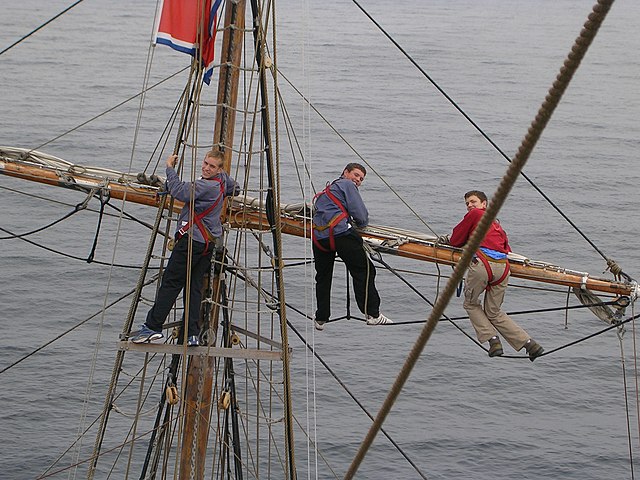The lug sail, or lugsail, is a fore-and-aft, four-cornered sail that is suspended from a spar, called a yard. When raised, the sail area overlaps the mast. For "standing lug" rigs, the sail may remain on the same side of the mast on both the port and starboard tacks. For "dipping lug" rigs, the sail is lowered partially or totally to be brought around to the leeward side of the mast in order to optimize the efficiency of the sail on both tacks.
A replica of a longboat from the French frigate La Résolue The original was captured in 1786 in Bantry and is now in the National Museum of Ireland. Such replicas are referred to as a Yole de Bantry.
A yard is a spar on a mast from which sails are set. It may be constructed of timber or steel or from more modern materials such as aluminium or carbon fibre. Although some types of fore and aft rigs have yards, the term is usually used to describe the horizontal spars used on square rigged sails. In addition, for some decades after square sails were generally dispensed with, some yards were retained for deploying wireless (radio) aerials and signal flags.
The fore royal yard on the Prince William. Prince William's royal yards are the highest and smallest yards on the ship, are made of wood, and are "lifting yards" that can be raised along a section of the mast. Here it is in the lowered position.
A view of Stavros S Niarchos's main-topgallant yard shortly after maintenance, clearly showing its various parts. On relatively "modern" late-nineteenth-century rigs like this, the quarters make up almost all of it. Click the picture for more details.
The yards are mounted on the mast in such a fashion as to allow free movement under the control of lifts and braces. The sail on this yard is "in its gear" (see Setting section)--it is hanging below the yard but still folded up rather than spread to the wind.
The fore course is stowed neatly on top of its yard. On the Prince William this yard is made of steel, does not lift, and weighs around two tons. The two people higher up are working on the fore lower topsail yard. Here, the sails are bent only to the yards' quarters and the yardarms are very short.





